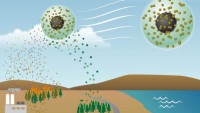There’s a 'Lost Continent' Under Mauritius, Researchers Confirm
| Arthur Dominic Villasanta | | Feb 03, 2017 11:32 PM EST |
(Photo : Susan Webb/Wits University) Prof. Lewis Ashwal studying an outcropping of trachyte rocks in Mauritius.
There does indeed exist a "Lost Continent" under the island of Mauritius in the Indian Ocean formed after by the break-up of the supercontinent called Gondwana some 200 million years ago.
But before this event, or some 335 million years ago, Gondwana (the southern continent) and Laurasia (the northern continent) joined together to form the supercontinent Pangaea, which existed until 215-175 million years ago. Gondwana then separated from Laurasia and later also broke apart.
Like Us on Facebook
Gondwana included most of the landmasses in today's Southern Hemisphere, including Antarctica, South America, Africa, Madagascar and Australia.
"We are studying the break-up process of the continents, in order to understand the geological history of the planet," said Prof. Lewis Ashwal of the University of Witwatersrand in South Africa and lead author on the paper published in the prestigious journal Nature Communications.
"Archaean zircons in Miocene oceanic hotspot rocks established an ancient continental crust beneath Mauritius."
Archaean refers to the Archean Eon, a geologic eon some 4 billion to 2.5 billion years ago. Zircon is one of the key minerals used by geologists in geochronology, which is the science of determining the age of rocks, fossils and sediments using signatures inherent in the rocks themselves.
Zircons are minerals that occur mainly in granites from the continents. They contain trace amounts of uranium, thorium and lead. Because they survive geological process very well, they contain a rich record of geological processes and can be dated very accurately.
By studying the mineral, zircon found in rocks spewed up by lava during volcanic eruptions, Ashwal and his colleagues (Michael Wiedenbeck from the German Research Center for Geosciences (GFZ) and Trond Torsvik from the University of Oslo) have found that remnants of this mineral were far too old to belong on the island of Mauritius.
"Earth is made up of two parts -- continents, which are old, and oceans, which are "young," said Ashwal.
"On the continents, you find rocks that are over four billion years old, but you find nothing like that in the oceans, as this is where new rocks are formed.
"Mauritius is an island, and there is no rock older than 9 million years old on the island. However, by studying the rocks on the island, we have found zircons that are as old as 3 billion years."
"The fact that we have found zircons of this age proves that there are much older crustal materials under Mauritius that could only have originated from a continent."
Ashwal said their finding ancient zircons in six million-year-old trachyte rocks (an igneous volcanic rock) corroborates a previous study and refutes any suggestion of wind-blown, wave-transported or pumice-rafted zircons for explaining the earlier results.
"According to the new results, this break-up did not involve a simple splitting of the ancient super-continent of Gondwana, but rather, a complex splintering took place with fragments of continental crust of variable sizes left adrift within the evolving Indian Ocean basin."
TagsLost Continent, mauritius, Indian Ocean, Gondwana, Laurasia, Prof. Lewis Ashwal, University of Witwatersrand, Archaean zircons, Zircon
©2015 Chinatopix All rights reserved. Do not reproduce without permission
 AI Named ‘Libratus’ Finally Beats Human Pros at Poker -- Incredible
AI Named ‘Libratus’ Finally Beats Human Pros at Poker -- Incredible Scientists Uncover More about how Sex-Hormone-Sensitive Neurons Trigger Attraction
Scientists Uncover More about how Sex-Hormone-Sensitive Neurons Trigger Attraction Only Three Student Teams Manage to Race in SpaceX’s First Hyperloop Competition
Only Three Student Teams Manage to Race in SpaceX’s First Hyperloop Competition Some Pollutants can Travel Around the World and Increase Lung Cancer Risks
Some Pollutants can Travel Around the World and Increase Lung Cancer Risks
EDITOR'S PICKS
-

Did the Trump administration just announce plans for a trade war with ‘hostile’ China and Russia?
-

US Senate passes Taiwan travel bill slammed by China
-

As Yan Sihong’s family grieves, here are other Chinese students who went missing abroad. Some have never been found
-

Beijing blasts Western critics who ‘smear China’ with the term sharp power
-

China Envoy Seeks to Defuse Tensions With U.S. as a Trade War Brews
-

Singapore's Deputy PM Provides Bitcoin Vote of Confidence Amid China's Blanket Bans
-

China warns investors over risks in overseas virtual currency trading
-

Chinese government most trustworthy: survey
-

Kashima Antlers On Course For Back-To-Back Titles
MOST POPULAR
LATEST NEWS
Zhou Yongkang: China's Former Security Chief Sentenced to Life in Prison

China's former Chief of the Ministry of Public Security, Zhou Yongkang, has been given a life sentence after he was found guilty of abusing his office, bribery and deliberately ... Full Article
TRENDING STORY

China Pork Prices Expected to Stabilize As The Supplies Recover

Elephone P9000 Smartphone is now on Sale on Amazon India

There's a Big Chance Cliffhangers Won't Still Be Resolved When Grey's Anatomy Season 13 Returns

Supreme Court Ruled on Samsung vs Apple Dispute for Patent Infringement

Microsoft Surface Pro 5 Rumors and Release Date: What is the Latest?










